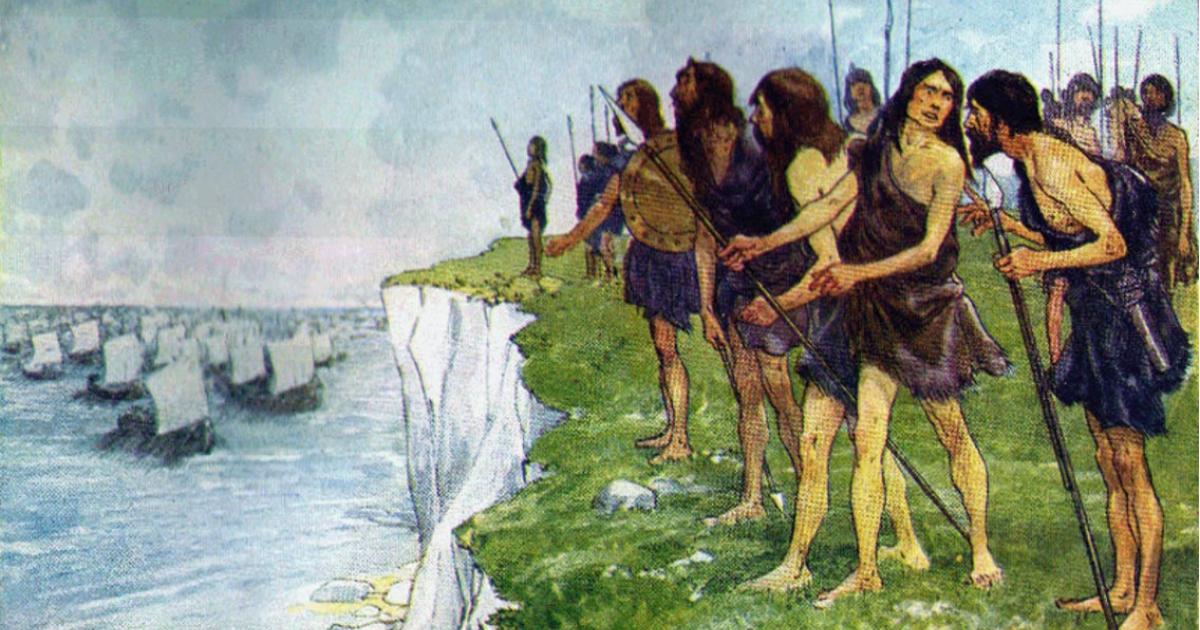
Waves of invaders came to Britain but left few genes, new study says
People who came from prehistoric Germany, Belgium and France beginning about 11,000 years ago seem to have contributed the most genetic material to modern Caucasian Britons, according to a new study.
The genetic study of British white people shows their dominant ancestry pre-dates the most recent invaders – the Anglo-Saxons, Vikings, Normans and Romans. But of those four, the group that contributed the most genes was the Anglo-Saxons, who invaded in the fifth century AD.

The Battle of Hastings, fought between the Anglo Saxons and the Normans on British soil (Wikimedia Commons)
Also, there is no large single Celtic DNA group outside Anglo-Saxon areas of Britain, but several genetically distinct populations of Celtic people. “I had assumed that there was going to be this uniform Celtic fringe extending from Cornwall through to Wales into Scotland. And this has very definitely not been the case,” archaeologist Mark Robinson told the Daily Mail.
The Orkney Islands are the only area where the people have significant Viking ancestry, the study found. The Orkney Islands were Norwegian territory for 600 years. About 25 percent of the Orkney people’s genes are Viking.

The Vikings arrived in Orkney and settled there. (Wikimedia Commons)
The modern people of Wales most closely hew genetically to Stone Age peoples, the study says.
A bit less than half of modern Britons have Anglo-Saxon ancestry, says the new study of 2,039 people from England, Scotland, Wales and Northern Ireland. Anglo-Saxon genes comprise about 10 to 50 percent of this group’s total genetic makeup, says the journal Nature. Most of the Anglo-Saxon ancestry is in England proper.
“We estimate the genetic contribution to southeastern England from Anglo-Saxon migrations to be under half, and identify the regions not carrying genetic material from these migrations,” wrote the authors in the article in Nature, which one must pay to access. “We suggest significant pre-Roman but post-Mesolithic movement into southeastern England from continental Europe, and show that in non-Saxon parts of the United Kingdom, there exist genetically differentiated subgroups rather than a general 'Celtic’ population.”
The authors said most of the genetic heritage of the United Kingdom comes from after the time of the first migrations into the islands, around 10,000 to 11,000 years ago, to before the Roman invasion of 55 BC. Modern Britons’ genes most resemble people from Germany, France and Belgium. People may have gone to the islands from those areas long ago via a land bridge. Also, some came from what is now France by boat.

The Roman invasion of Britain: ‘The Standard-Bearer of the Tenth Legion’: a portrayal of the Roman Tenth Legion’s landing at England in 55 BC. (Wikimedia Commons)
The researchers took DNA samples from the 2,039 Caucasian United Kingdom citizens whose four grandparents were born within 80 km (50 miles) of each other. The grandparents’ year of birth, averaged out, was in 1885, which predates significant recent immigrations to the British Isles that would have changed the genetic heritage. The researchers then compared the Britons’ DNA to the DNA of 6,209 continental Europeans.
“Any one person's genome is a random sample of DNA from all four of their grandparents, so it's a way to look back in time,” Peter Donnelly of the Wellcome Trust Centre for Human Genetics in Oxford told New Scientist.
The researchers looked for common combinations of genetic alterations inherited in large groups of chromosomes instead of single genetic alterations. This allowed them to identify differences among people with similar genetic makeups. Donnelly called it a “much richer” way of looking at people’s genetic differences.
Britons who participated in the study were grouped into 17 distinct clusters of genetic profiles. The largest cluster, which had about half the participants, occupies eastern and southern England and the Midlands—the same areas occupied by their ancestors. These are the people with DNA from the Anglo-Saxons. But people from that large group had at most 40 percent Anglo-Saxon DNA, and 60 percent of these people’s DNA was from earlier immigrants.
Featured image: The Roman conquerors are waited for by the men of Albion. (Wikimedia Commons)
By Mark Miller
















Comments
I found this study very interesting, particularly that they found areas of subtle genetic differences, such as West Yorkshire, which corresponds roughly to the ancient British Kingdom of Elmet. What I also found fascinating was the different slants that different articles took on the same information. I’ve read several articles, as well as the original source document, and it was interesting to see how this got translated into subtly different interpretations.
A very interesting subject that I’m sure we will hear more about in the years to come. Thanks for the article!
Sculptures, carvings & artwork inspired by a love of history & nature: www.justbod.co.uk